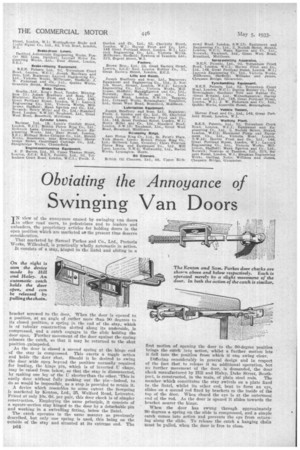Obviating the Annoyance of
Page 138

If you've noticed an error in this article please click here to report it so we can fix it.
Swinging Van Doors
IN view of the annoyance caused by swinging van doors to other road users, to pedestrians and to loaders and unloaders, the proprietary articles for holding doors in the open position which are marketed at the present time deserve consideration.
. • That marketed by Samuel Parkes and Co., Ltd., Pretoria Works, Willenhall, is practically wholly automatic in action. It consists of a stay, hinged to the lintel and sliding in a bracket screwed to the door. When the door is opened to a position, at an angle of rather. more than 90 degrees to its closed position, a spring in the end of the stay, which is • of tubular construction slotted along its underside, is compressed, and a catch engages in the slide holding the door open. Further movement of the door against the spring releases the catch, so that it may be returned to the shut position--.unimpeded.
As the door is closed a second spring at the hinge end • of the stay is compressed. This exerts a toggle action and holds the door shut Should it be desired to swing the door .wide open beyond the position normally required for loading the hinge pin, which is of inverted U shape, may be 'raised from below, so that the stay is disconnected, by making one leg of the U shorter than the other. This is easily done without fully pushing out the pin—indeed, to do so would be impossible, as a stop is provided to retain it.
A device which resembles to some extent the foregoing is marketed by Kenton, Ltd., 25, Welford Road, Leicester. Priced at only 10s. 6c1. per pair, this door check is of simpler construction. Employing the same principle, it consists of it square-section stay hinged to the door by a detachable pin and working in a swivelling fitting, below the lintel.
The catch operates in the same manner as previously described, but only one spring is used, this being on the outside of the stay and situated at its extreme end. The 1164 first motion of opening the door to the 90-degree position brings the catch into action, whilst a further motion lets it fall into the position from which it can, swing clear.
Differing considerably in general design and in respect of the fact that to release it an additional operation, but no further movement of the door, is demanded, the door cheek manufactured by Hill and Haley, Duke Street, South port, is constructed, in the main, of plain steel rods. The member. which constitutes the stay swivels on a plate fixed to the lintel, whilst its other end, bent to form an eye, slides on a second rod fixed by brackets to the inside of the top of the door. When closed the eye is at the outermosi, end of the rod. As the door is opened it slides towards the bracket nearer the hinge.
When the door has swung through approximately 90 degrees a spring on the slide is compressed, and a simple catch comes into action and prevents the eye from returning along the slide. To release the catch a hanging chain must be pulled, when the door is free to close.




























































































































































































